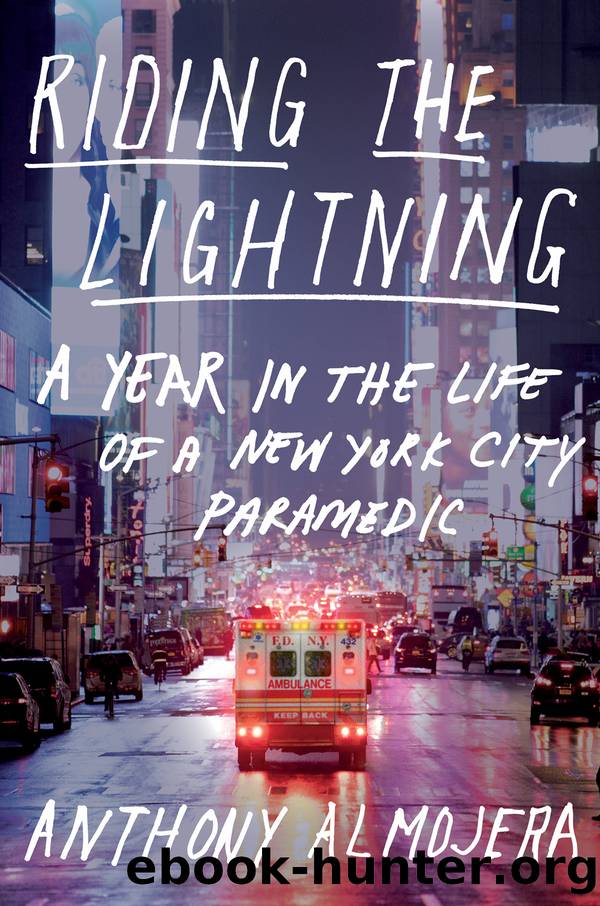Riding the Lightning by Anthony Almojera

Author:Anthony Almojera [Almojera, Anthony]
Language: eng
Format: epub
Published: 2022-06-07T00:00:00+00:00
Picture this: An EMS station in New York City. Itâs a morning in early spring 2020. Outside the station, thereâs a big truck. Itâs full of boxes. The doors to the station are open. Smiling EMS workers unload the boxes from the truck. They pass them hand to hand in a line. An EMS lieutenant ticks off items on a list. Another member directs the boxes to the storage area downstairs. The boxes contain N95 masks of all sizes, gowns, gloves, face shields. Cots so that service members can sleep at the station if they need to. Pillows, blankets. Microwavable meals. Washing machines so they can launder contaminated uniforms.
In the middle of all the activity, Lillian Bonsignore, the EMS chief, arrives. She climbs onto the step of an ambulance thatâs parked outside the station. The members gather around. She delivers a rousing speech: âWeâre facing the unknown. Itâs going to be hard. But weâve got your backs. We are all in this together. And remember,â she says, âweâre New Yorkâs Best!â
That would have been a heartening scene, right? Like a rousing movie sequence in which whistling soldiers set up camp in preparation for war.
Sadly, it never happened.
There was no truck bursting with supplies. There was no visit from the EMS chief. There was no line of cheerful EMTs. The fire department continued to send buck slipsâinternal memos about which mask to wear and when to wear it, what PPE to use, how to triage a suspected COVID case. But they provided little in the way of supplies. And less in the way of moral support.
To be fair, a couple of stations did receive washing machines.
With little guidance from the higher-ups, weâd tried to handle the preparations ourselves. During the first week of March, Iâd gone down into the basement of Station 40 with Bones to look at our stocks of masks and gowns. Bones was in charge of keeping track of basic life support supplies for the station. The basement was stacked with BLS materials: four-inch-square gauze bandages used for most wounds; neck braces; stair chairs; oropharyngeal airways (hook-shaped tubes used to keep patientsâ airways open); sterile water for washing wounds; cold packs; obstetrical kits (infant swaddle, placenta bag); urinals; plastic tubs for stowing needles and other sharps. There was a box of red felt Christmas stockings, each decorated with a memberâs name. A plastic Christmas tree.
Bones and I counted the boxes of N95 masks. There were half a dozenâthat added up to a few hundred masks.
That was nothing out of the ordinary. In normal times, very few people wore masks of any kind. If you had a patient who was coughing or vomiting, youâd wear a surgical mask, one of the blue and white ones that New Yorkers snapped up during the early days of the pandemic. Those we had boxes and boxes of.
Surgical masks are made of polypropylene, a nonwoven papery substance that allows air to pass through it but not droplets of moisture. So if youâre wearing a surgical mask and somebody sprays blood on you, the mask will catch those droplets.
Download
This site does not store any files on its server. We only index and link to content provided by other sites. Please contact the content providers to delete copyright contents if any and email us, we'll remove relevant links or contents immediately.
Machine Learning at Scale with H2O by Gregory Keys | David Whiting(4177)
Never by Ken Follett(3789)
Harry Potter and the Goblet Of Fire by J.K. Rowling(3773)
Unfinished: A Memoir by Priyanka Chopra Jonas(3331)
Fairy Tale by Stephen King(3220)
The Man Who Died Twice by Richard Osman(2996)
Will by Will Smith(2791)
Rationality by Steven Pinker(2291)
The Dark Hours by Michael Connelly(2243)
Can't Hurt Me: Master Your Mind and Defy the Odds - Clean Edition by David Goggins(2225)
It Starts With Us (It Ends with Us #2) by Colleen Hoover(2196)
The Storyteller by Dave Grohl(2171)
The Dawn of Everything: A New History of Humanity by David Graeber & David Wengrow(2122)
Friends, Lovers, and the Big Terrible Thing by Matthew Perry(2118)
The Becoming by Nora Roberts(2087)
The Stranger in the Lifeboat by Mitch Albom(2050)
Cloud Cuckoo Land by Anthony Doerr(2033)
Einstein: His Life and Universe by Walter Isaacson(1967)
Love on the Brain by Ali Hazelwood(1963)
